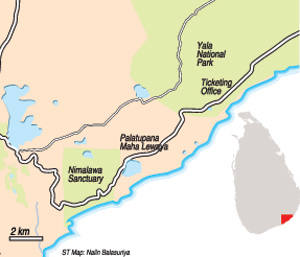News
No sanctuary for this leopard
In more sad news from Yala, the body of a female leopard was found on Friday inside Yala National Park itself, on the verge of the Jamburagala road. The body had no apparent scars but the postmortem revealed the leopard died due to a broken neck (spinal code). There was evidence that some elephants had passed through the area in which the leopard was lying but it was unlikely that the death could have been due to an attack by elephants as adult leopards never confront elephants.
It is probable that the leopard died after being hit by a speeding vehicle, Wildlife Conservation Department (DWC) Director General H.D. Ratnayake said. No culprit has been nabbed yet but there will be an investigation about the death of this leopard, he said.
 Yala is the busiest national park in Sri Lanka with its key attraction being the leopards. The safari jeep drivers and other visitors always want to see a leopard so any leopard sighting is swiftly communicated through mobile phones to other jeeps that then flock to the area for a glimpse of the prized big cat.
Yala is the busiest national park in Sri Lanka with its key attraction being the leopards. The safari jeep drivers and other visitors always want to see a leopard so any leopard sighting is swiftly communicated through mobile phones to other jeeps that then flock to the area for a glimpse of the prized big cat.
The park is closed every day at 6 p.m., so jeeps that go deep into the jungle without a sense of the time, speed their way toward the exit at closing time, and this could lead to accidents like this. This is not the first leopard killed by speeding vehicles inside Yala National Park. In 2011, a leopard was killed by a speeding vehicle and since then, several animals too has been reported killed by speeding vehicles.
Mobile phones are a big factor in these Mad Max-type situations in Yala as they are used to pass on the message of leopard sightings. Heeding requests from conservationists, the DWC, in collaboration with mobile phone operators, in experimenting with cutting off service inside the park, Mr. Ratnayake revealed.
The network was switched off on alternate weeks this month. The leopard death occurred during a time when phones were active, according to local sources, indicating that a total blackout could improve the situation to some extent. It is, however, the responsibility of visitors not to allow the jeep to speed up for the sighting of a leopard. Jeep drivers speed in order to give tourists a better sighting, which will mean a bigger tip, so ask them not to speed up, conservationists say.
Local sources say that as many as five leopards have died this year in Yala due to various causes. A leopard was killed a few months ago in the buffer zone in Dambewa after being caught in a wire trap. The remains of another leopard was found near Rathmalwewa in Yala about a month ago.
 Earlier this week a tourist bus hit a herd of deer on the Kirinda-Yala road, reinforcing concerns that the road has become a death-trap for wildlife as its newly-carpeted surface allows motorists to speed. No carcasses or wounded deer could be seen on the road after Wednesday’s accident but blood on the road indicated that several animals could be badly injured.
Earlier this week a tourist bus hit a herd of deer on the Kirinda-Yala road, reinforcing concerns that the road has become a death-trap for wildlife as its newly-carpeted surface allows motorists to speed. No carcasses or wounded deer could be seen on the road after Wednesday’s accident but blood on the road indicated that several animals could be badly injured.
It was dark at the time of the accident and the wounded animals sought refuge in the jungle. Conservationists worry that even if these deer do not die as a direct result of their injuries the wounds could become infected and make the animals less mobile,making them easy prey for predators.
On August 21, a deer was hit and killed by a motorist who sped off without waiting to be identified, leaving the animal suffering by the side of the road. It was the ninth deer known to have been killed in the past three months since that stretch was resurfaced to provide a comfortable ride for park visitors, local resident Sampath Galappaththi said.
The fact that large animals like deer are being killed on the road indicates smaller animals and birds are being killed in larger numbers, unnoticed.
Mr. Galappaththi revealed that carcasses of nightjars, a nocturnal bird, have become a common sight on the road.
Mr. Ratnayake said he was aware of the problem. He said that as the road comes under the Road Development Authority, the DWC would hold talks with the authority to find a solution. In the meantime, he urged motorists to be careful when driving on roads bordering on or passing through through wilderness areas.
Drought break for wildlife
The Yala National Park will be closed for one month from September 7.
The Department of Wildlife Conservation (DWC) announced this week that Yala, the country’s mostly visited national park, is closing during the height of the drought to ease the pressure on the animals from visitors.
The break also gives an opportunity to repair infrastructure in the park.
The tradition of closing the park at this time started in colonial days when the park was a game reserve providing hunting opportunities.

